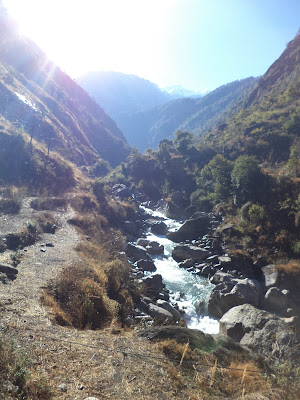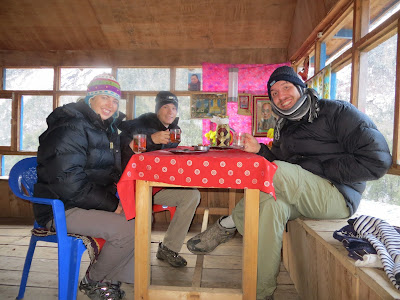The story of my trekking on the Nepali Himalayas, just like
so many of the amazing things that have happened to me during my journey,
starts with a dramatic twist in my travel plans. Initially, my trip to Nepal
was supposed to be mainstream enough: go there, see some temples, check out
Kathmandu and some beautiful stupas, visit Lumbini, Buddha’s birthplace, and
that’s it. Nice and smooth. However, the goddess of indie travel had something
else in mind for me, and her plans were in action even before I entered Nepal.
On February 11th, my friend Giselle and I, the only
survivors from the 10-peoplegroup that left Kolkata on Jan 24th,
took a train from New Delhi to Gorakhpur, meaning to cross the border into
Nepal. On that train I have met a very friendly American couple, Sarah and
David, and we have quickly warmed up to each other during the 16-hour ride.
After crossing the border, we said our goodbyes to them, as we were headed to
Kathmandu, and they were going to the Chitwa National Park elsewhere in Nepal.
After some days in Kathmandu, Giselle and I were walking on
the street trying to find the correct bus stop to take a ride to Bhaktapur, a
nearby city, when we heard a distinct “HEY!”. David and Sarah were having lunch
in a restaurant we were passing in front of. It was a happy coincidence, and
there I learned they were going trekking on some Himalayan trails in two days,
and they kindly invited me in. Lucky me.
On the following day, I accompanied Sarah and David to a
shop where they were going to buy some gear they needed, and right there on the
spot I made up my mind to join them. I bought a synthetic T-shirt and a shirt,
two trekking poles, a fleece jacket, cargo pants, rain jacket and pants, warm
underpants, a hat, backpack cover, 3 pairs of socks, a Nalgene water bottle,
all for a little over 115 dollars. I also rented a heavy jacket and a sleeping
bag, and I was good to go.
The next sunrise found me and Giselle saying our goodbyes –
after almost a month travelling together. I met David and Sarah and we took the
bus to Shyafru Bensi, a little town at 1,500m high, just at the beginning of
the Langtang Trail, our trekking route of choice. The bus ride was nightmarish:
the only seats available were on the back of the bus, the bumpiest, least comfortable
place in a non-comfortable-at-all bus. We thought we would die a thousand
times: the Nepali drivers take no prisoners and the roads are narrow, bumpy,
with endless abysses inviting us to a horrible death at every turn. I have made
a little video , about it, though it does not convey the full atmosphere of the
situation:
Luckily, the way was also beautiful, and the toilet breaks
had an amazing scenery:
We reached a rainy Shyafru Bensi already battered up, and
the trek had not even started! After dinner, we went over our trekking plans
again at the hotel, and went to sleep hoping for clear skies and dreaming with
the heights.
On the next morning, we packed our things tight, stretched
our trekking poles, and hit the trail. The Langtang Trail, named after the
biggest village on the mountain, stretches all the way from Shyafru Bensi, at
1,500m, to Kianjin Gumba, at 4,000m, roughly following a big river, and
combines spots of lush green and steep rocky stairways with large extents of
snow trails and open plains surrounded by the beautiful snowy peaks of the
Himalayas.
The first day was great: a perfect weather found us
well-rested, energized and as excited as ever. We were greeted by a beautiful
river and crossed some small villages and sturdy metal bridges covered with the
ubiquitous multicolored prayer flags of the Tibetan Buddhists.
After four hours trekking, we arrived at the first big
teahouse, Bamboo Lodge, where we had lunch and some well-deserved rest.
We were already very tired, and briefly considered spending
the night there. However, as Bamboo Lodge was still halfway the distance we had
intended to cover in the first day (first lesson learned: it is so much easier
to plan for big treks from your hotel bed than with a 30kg backpack on your
shoulders), we decided to put a little extra effort into it and go at least
until the next teahouse, at Rimche. At Bamboo I also decided I was carrying too
much weight (second lesson learned: your perception of what is essential to
carry with you changes dramatically after having to carry those perceptions on
your back uphill for six hours). I took off a good 5kg of trash from my luggage
and the lodge’s owner kindly let me leave it all there to retrieve on my way
back. After two more hours, we finally arrived at Rimche, where I almost
immediately fell asleep.
We woke up before the sun was up the next day and set out
for the next leg in our journey. The
trail started getting more and more rough, but the scenery also grew more
beautiful, with us getting closer and closer to the beautiful mountains ahead.
At some points the trail was little more than a narrow strip
separating as steep rock from the abyss at our side, and sometimes the
teahouses on the way were little more than a single building defiantly sitting
in the middle of the immensity of the valley. For me, all these impressions
added up to create a surreal sense of reality, as if all of that was a
particularly long dream.
At that point I was already sufficiently awe-struck to make
this video (my ramblings are in Portuguese, sorry).
Up we went, uneventfully reaching our next goal: the
teahouse called Hotel Peaceful in Chianki, where our friend Norbuk, the owner,
was more than happy to provide us with his hospitality and 100-rupee tea cups.
In the mountain, especially at high altitudes, resources are
scarce, and almost nothing gets wasted. The mountain people usually have Yaks
(a beast resembling a small, hairy cow) for milk and fur – not for meat,
though, because Tibetan Buddhists are not allowed to kill animals (if a Yak
dies of an accident, however, it’s barbecue time!). The Yak dung is collected,
dried, and then used as fuel, along with firewood, for the stoves that warm the
chilling nights. We had never been so happy to see a big pile of dung before.
On the third day of ascent, the world turned white. The
trail became snow-ridden, the ground slippery, and the snowy peaks we used to
admire from a distance now surrounded us from all sides.
And then, after some more hours of battling the knee-deep
snow, we finally reached Kianjin Gumba, at 4000m high, our last inhabited stop.
In Kianjin Gumba, the rest of the day was devoted to
resting, warming up, and being beautiful.
In the morning of the fourth day we set out to climb the
Kiang Ri, a “small” (at 4,500m, more than half an Everest, it was the smallest
and most accessible peak around, just behind the village) friendly ice-covered
rock. The climb was not very difficult, but it was tiresome. Personally, as I
had never seen snow before this trip, I had a lot of trouble with the white
crap: I would slip uncountable times, relying on my trekking poles to avoid
falling and rolling down the slope to a horrible death.
And then, three hours later, we finally reached the top,
finding an exhilarating view of the valley around us, the glacier, and the
surrounding peaks and mountains.
 |
| King of the hill |
 |
| A bit of national pride |
 |
| Lookin' good. |
 |
| The valley of Kianjin Gumba |
 |
| See the village down there? |
So we started our way down. The next three hours were the
only part of the trek in which I felt genuinely afraid for my safety. The
morning sun had half-melted the snow, making it ten times more slippery, and
giving up more easily to our weight. To a greenhorn in both climbing AND
dealing with snow such as me, that was serious trouble. Early into the descent,
I slipped, fell to my butt and started sliding down the slope uncontrollably.
Luckily I was able to reflexively stick my trekking poles in the ice and coming
to a halt, but one of my trekking poles paid the price with its life: it was
broken for good.
After that, without the trekking poles to rely upon, I
started a careful descent on my own hands and legs. I took off my gloves for an
extra grip, even though it was freezing cold, and decided to avoid the snow
altogether, trying instead to go from rock to rock, bush to bush, even if that
meant going a longer way. To the hell with my palms (which were really
scratched) and my boots (which suffered their lot in silent agreement) – at the
moment, I just cared about reaching the village alive and in one piece. Shaky
and relieved, and in no mood for pictures, I finally arrived at our lodge,
celebrating my success with a big belly-slide on the snow. Afterwards, I
quickly found my way to food and bed, and slept as a rock.
On the next morning, it was time to say goodbye to our host,
Kianjin Gumba, and start our long descent.
The way down was way faster and less tiresome, but it was no easier than the way up: our bodies were already tired from the exertion of the last four days, and going down is much harder on your knees and shoulders. Despite that, we made our way to Shyafru Bensi in only two days (as opposite to the three it took us to go up), in two 6-hour hikes. The last two hours were particularly tiresome: on top of being exhausted from all the trekking, the extra weight I had left at Bamboo Lodge really made me miserable until reaching our hotel room in Shyafru. Miserable, but happy as a little kid with a new Lego set. On his birthday. With cake. And a puppy.
Trekking on the Himalayas was an once-in-a-lifetime
experience, one that will be engraved in mind for the rest of my life. It is as
much a journey into oneself as it is a physical feat, as it gives you plenty of
time to think and reflect on your life, combined with trance-like periods of
intense concentration on the task at hand, as there are times in which a simple
mistake can be fatal. I really feel like I have emerged as new being after this
experience, and I will be forever grateful to Sarah and David for taking me
along and offering me guidance, advice, and friendship.
Namaste!





































Nenhum comentário:
Postar um comentário